Glassware Matters: Get The Most From Your Wine
Glassware Does Matter: Why You May Not Be Getting The Most From Your Wine
Read Our Glassware Guide to An Elevated Wine-Tasting Experience
Start with a good splash of half-decent Sancerre or red Burgundy - but in a whiskey tumbler. Give it a swirl. In goes your nose... Not so much there, is there? Now, a sip from that thick rim. Still not much?
No. Because clearly, you’ve used the perfectly wrong vessel for the purpose at hand. And although the tumbler may serve as an extreme example, still, you’ve just squandered a lovely drop on what, by design, is incapable of capturing then delivering to your senses all that’s coiled up in that drop: all the enticing aromas, intriguing complexities and joie-de-terroir this £20 bottle was supposed to provide.
Does wine glass shape affect taste, then? And if so, which ones will help you get the most out of your wine from hereon in? In this wine glassware shapes guide, we’re going to break down some basics on design, composition, grape varietal and key wine regions to ensure this ‘hereon in’ starts today.
Wine Glass Shapes Explained
To any sommelier, proper glassware is indispensable. Any somm will confirm that correct glassware accentuates a wine’s character. That the right vessel amplifies specific aromas and flavours, thus ensuring that a simple sip makes a far greater impression. This is because different wine glasses’ shapes are thoughtfully designed for introducing a wine to the palate in a specific way and once there, to direct it to particular parts of that palate.
Details like bowl shape, rim width, and even stem length all play a role in how we perceive a wine’s aroma, flavour, and structure. Premium glassware from such renowned producers as Riedel, Zalto, and Zwiesel Glas is crafted with thin, high-quality crystal that helps wine breathe and settle at the perfect temperature, providing a purer, more refined tasting experience.
Perfect Glassware for Popular White Wines
Chardonnay: Burgundy, California, South Africa, Australia
Because chardonnay expression is often rich and complex – particularly as rendered in many parts of Burgundy and California – the ideal glass shape for such full-bodiedness is a wide-bowled glass with a large opening. You guessed it – a ‘Burgundy glass.’ Its shape allows more oxygen interaction with the wine, thus unfurling its full array of aromas and nuances, as well as softening and balancing out any initial sharpness of acidity.
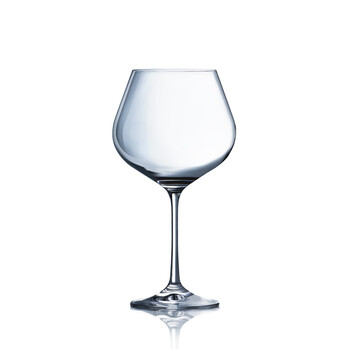
Top Picks: Riedel Oaked Chardonnay Glass or Zalto Denk’Art Burgundy Glass
Other Varietals/Regions: Chablis, viognier/Côtes-du-Rhône Blanc, Condrieu, marsanne, roussanne.
Sauvignon Blanc: Loire Valley to Marlborough
Sancerre, Pouilly-Fumé, Touraine, New Zealand, Chile… a true international varietal. An eternal favourite offering invigorating aromatics, a crisp, zesty, citrus, tropical fruit profile, smoky, flinty minerality and vibrant acidity.
So, choose a narrower glass with a small bowl for an optimum sauvignon blanc-tasting experience. This channels the varietal’s intrinsic aromatic intensity while maintaining its refreshing quality. The shape also preserves the wine’s crispness while highlighting the herbal and citrus notes that so define the varietal.
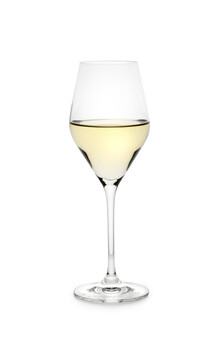
Top Picks: Riedel Sauvignon Blanc Glass or Zwiesel Glas Pure Sauvignon Blanc Glass
Other Varietals/Regions: chenin blanc, albariño, bacchus, Soave, muscadet.
Riesling: Germany and Alsace
Like sauvignon blanc, riesling is categorised as a true aromatic varietal. Hugely diverse in its stylistic possibilities, it will often showcase a thrilling balance of sweetness and acidity, making it an ideal candidate for a tulip-shaped glass. Such a shape captures riesling’s delicate floral and fruit notes, focusing the aromas directly to the nose, thus intensifying one’s experience of its aromatic complexity.
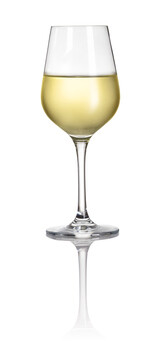
Top Picks: Zalto Universal Glass or Riedel Riesling/Zinfandel Glass
Other Varietals/Regions: grüner veltliner, pinot blanc, pinot gris. rosés
Best Glassware for Red Wines
Pinot Noir: Burgundy, California, Oregon
To fully liberate what enchanting, floral, cherry-fruited, spicy, earthy aromatics and flavours your pinot noir has in store, ensure you’re sipping from spacious, tulip-shaped glassware having a large, rounded bowl and openly-tapering rim.
Such a glass allows air to flow freely over the wine’s surface, maximise its interaction with oxygen molecules, then diffuse into the nose the delicate aromas this interaction opens up. The voluminous shape of a pinot noir glass also serves to soften the vibrant level of acidity that is typical of the varietal.
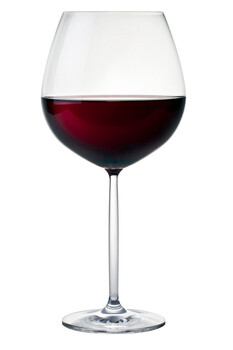
Top Picks: Riedel Burgundy Grand Cru Glass or Zalto Burgundy Glass
Other Varietals/Regions: red Burgundy/pinot noir, Barolo/Barbaresco/nebbiolo, gamay/cru Beaujolais.
Cabernet Sauvignon: Bordeaux, California, Argentina, South Africa, Australia
Full-bodied, deeply flavoured, robustly structured, cabernet sauvignon demands both ample aerating space and height. For this, a tall, broad-bowled glass with slightly tapered rim to guide the wine to the back of the palate.
Thus delivered, this design enhances cabernet’s leafy, peppery, blackberry, capsicum aromas, juicy, dark-fruit flavours are enhanced while smoothing out what are so often firm tannins and good levels of acidity.
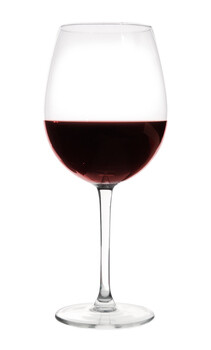
Top Picks: Riedel Vinum Cabernet/Merlot Glass or Zwiesel Glas Finesse Bordeaux Glass
Other Varietals/Regions: Brunello di Montalcino, merlot/Bordeaux Left Bank, cabernet franc/Loire red.
Syrah/Shiraz: Rhône Valley and Barossa Valley
The violet, peppery, smoky aromas and dark, bittersweet olive-fruit and earthiness of syrah (a.k.a. shiraz) are best enjoyed when captured and harnessed in a medium-to-large-sized bowl with a tapered rim. Good for tempranillo also and not dissimilar in structure to the cabernet glass, it too concentrates and focuses fragrances and flavours whilst refining the wine’s inherently tannic structure.

Top Picks: Riedel Vinum Syrah Glass or Zalto Bordeaux Glass
Other Varietals/Regions: grenache/Châteauneuf-du-Pape/Côtes-du-Rhône Rouge, malbec, tempranillo/Rioja, sangiovese/Chianti.
Glassware for Sparkling and Dessert Wines
Champagne and Sparkling Wines
While flutes are classic for champagne and sparkling wines, tulip-shaped glasses are gaining popularity since their comparative spaciousness allows for greater aromatic appreciation without sacrificing effervescence. A narrow stem helps retain bubbles while showcasing complex aromas that are often kept from full flourish in narrower flutes.
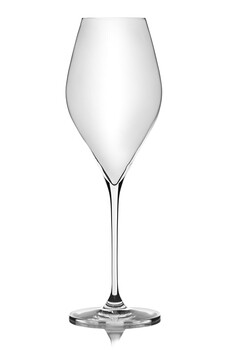
Top Picks: Zwiesel Glas Vervino Champagne Glass or Zalto Champagne Glass
Other Varietals/Regions: English sparkling wine, regional crémants, Cava, prosecco, Sekt
Dessert Wines: Sauternes, Royal Tokaji, Port, Sweet Sherry, Madeira
Dessert wines, fortified wines and ports, with their typical aromatic intensity, high residual sugar levels and correspondingly high ABV%, are most expressive when served in small, tapered glasses.
This design directs the wine to the tip of the tongue to highlight its corresponding intensity in sweetness and fruitiness. It also reflects the fact that dessert wines, owing to their inherent richness, are consumed in smaller volumes and at a more gradual pace.
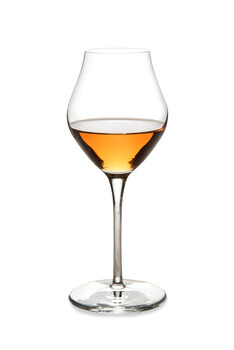
Top Picks: Riedel Vinum Port Glass or Zwiesel Glas Finesse Sweet Wine Glass
Glass and Glass Quality
The higher-quality glass that is blown for making such finery is usually made from fine crystal rather than standard soda-lime glass, which in turn enhances the tasting experience in the following ways:
Clarity and Brilliance: Crystal has a higher refractive index, providing a clearer, more brilliant view of the wine. This is especially prized when assessing a wine’s colour and clarity, which are visual indicators of its age, style, and potential quality.
Thinness and Lightness: High-quality glass, especially lead-free crystal, can be wrought to an amazing thinness without compromising durability. This enhances the tactile experience and allows for better temperature control, as the thin rim and walls prevent unnecessary heat transfer from the hand.
Durability and Resonance: Crystal is more durable and has a distinct resonance, producing a pleasant chime when tapped, which adds to the ceremonial aspect of wine tasting.
Why Crystal?
Fine crystal glasses, especially lead-free options, have an intricate lattice structure that makes them stronger yet lightweight and thinner. Historically, lead oxide was added to make the glass more malleable and durable, but today, higher-quality crystal often comprises alternative minerals like magnesium or titanium to maintain these qualities in place of lead.
The end result is a glass that provides brilliant clarity, strength, and a refined feel, thus heightening this combined sensory experience.
Practical Tips for Serving Wine in the Right Glass
Polishing and Handling: Use lint-free cloths and hold glasses by the stem to avoid fingerprints.
Temperature and Storage: Glasses should be room temperature and stored in a space without residual odours, which can alter the wine’s aroma.
Universal Glasses: For casual events or limited space, universal glasses like Zalto’s Universal Glass work well with a range of wines, offering a balanced approach.
Know Your Glassware, Maximise Your Pleasure
So, wine-drinker, how does your glassware collection look? Does your pinot noir swirl in a wide bowl, your claret enjoy ample breathing space, your sauvignon aromatics channelling where they should? If not, it’s time to ensure they do.
But don’t worry, you need not drop a wedge for this to happen. Most department stores and supermarkets offer entry-level, non-crystal versions of popular designs, usually in twos or fours, and ranging from £15 to £30. They’re all you’ll need to start discovering why certain wines, weights and intensities are best explored by way of specific glassware shapes.
Start with shape. Then, if/when you’re ready for what significantly enhanced pleasure crystal glass affords, you’ll find options from such boutique-level producers as mentioned in finer department stores or online. Expect to pay from around £25 and upwards per glass.
Either way, building a proper glassware collection and the knowledge of how to use it is how you get the most out of your wine. Wine glass shape matters, for it not only guarantees an elevated drinking experience, but also a far more detailed understanding of that experience. One sure to inspire a deeper exploration into the world of wine.
-- David Adamick, Mr.Wheeler Wine
